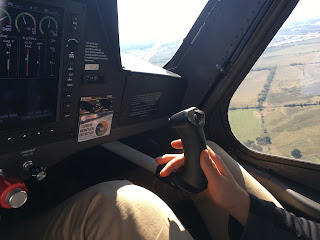And I liked it.
 |
| Garmin G300 (with upgrade - see below) |
 |
| GTU |
 |
| R base 36 we did extend out for inbound aircraft but we weren't as far out as this picture seems to indicate |
last three stock pictures - I forgot to take some from outside the plane
next text copy and paste from Wiki, seems right to me.
The Cessna 162 Skycatcher is an American side-by-side two-seat, high-wing, strut-braced, tricycle gear light-sport aircraft (LSA) that was designed and produced by Cessna between December 2009 and December 2013. It is the most recently introduced aircraft in the company's general aviationproduct line and the most recently canceled.
The Cessna 162 has a maximum gross take-off weight of 1,320 lb (599 kg) and a standard empty weight of 834 lb (378 kg). With a full fuel load of 144 lb (65 kg) the payload remaining for crew and baggage is 342 lb (155 kg).
In analyzing the imminent end of Skycatcher production Paul Bertorelli of AVweb indicated that the reasons for ending production were high price, poor useful load and lackluster flight performance compared to its LSA market competitors.
Data from Flying Magazine[ and Cessna.com
General characteristics
- Crew: one pilot
- Capacity: one passenger
- Length: 22.8 ft (6.95 m)
- Wingspan: 30.0 ft (9.14 m)
- Height: 8.53 ft (2.53 m)
- Wing area: 120 ft² (11.14 m²)
- Empty weight: 830 lb (376.5 kg)
- Useful load: 490 lb (222.3 kg)
- Max. takeoff weight: 1,320 lb (598.7 kg)
- Powerplant: 1 × Continental O-200D flat-four engine, 100 hp (74.6 kW)
Performance
- Maximum speed: 118 knots (218 km/h (136 mph))
- Cruise speed: 112 knots (207 km/h (129 mph))
- Range: 470 nm (870 km (540 smi.)) at 6,000 ft (1830 m)
- Service ceiling: 15,500 ft (4727 m)
- Rate of climb: 890 ft/min (4.52 m/s)
- Wing loading: 11.0 lb/ft² (55.0 kg/m²)
- Power/mass: 13.2 lb/hp (8.04 kg/kW)
My thoughts - I liked the castoring nose wheel - turned on a dime and created an ear to ear smile behind the yoke. I weigh in at 150-ish, most of the people I fly with weigh more - managing the fuel is a bit of a hassle (as a long term commitment to an airplane). A disadvantage for me was the flap lever. I was physically unable to pull the last ten degrees on final. I wish the flaps deployed with flips of a switch. I did like the engine (which is why the plane is heavier - Continental^ compared to Rotax powering the other LSA's I've flown. Not saying I didn't appreciate the Rotax*, just that the heavier engine has a different feel and might be a positive if I were looking to own. I do like the Flight Design Ct series ... all in all I probably lean that way, but this plane was a delight to fly. Cessna uses only AV 100LL where the Flight Design will readily accept Premium unleaded auto fuel or 100 LL Avgas (with a maintenance bump up in oil/filter changes)
^100 hp at 2750 RPM with a compression ratio of
8.5:1.
*Rotax 912 UL, 80 HP @ 5.800 rpm 1211 c.c.
9.0 to 1 Compression RatioGearbox: 2.27 to one reduction ratio





No comments:
Post a Comment